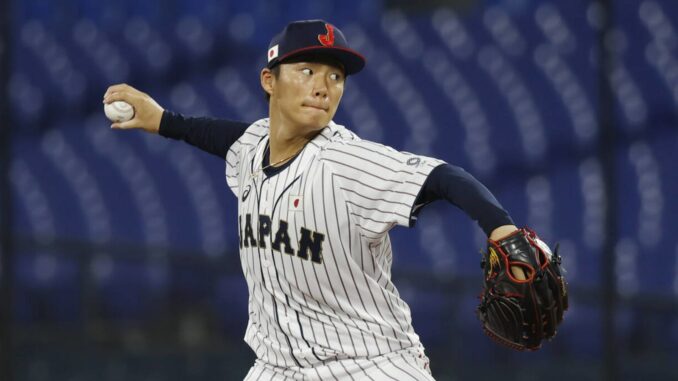
The Yoshinobu Yamamoto sweepstakes ended late last night, when the 25-year-old right-hander signed a 12-year contract with the Dodgers worth $325 million.

This huge figure is a record for free agent pitchers, aside from two-way superstar Shohei Ohtani, who landed Los Angeles a $700 million deal earlier this month with massive deferrals lowering his current value at around $460 million, skewing its value by Gerrit Cole. . nine-year, $324 million guarantee with the Yankees.Besides the Dodgers, the two New York teams were among the most aggressive suitors for Yamamoto’s services. Both the Yankees and Mets met with Yamamoto multiple times and reportedly made offers that appeared to match or even surpass Los Angeles’ in terms of aggressiveness. Previous reports indicated that the Mets offered Yamamoto a guarantee worth $325 million, while the Yankees offered $300 million over just ten years, raising the average annual value of the deal to $30 million. Following Yamamoto’s decision to move to Los Angeles, more details have been revealed about the two clubs’ ultimately unsuccessful efforts to land the right-hander. According to Ken Rosenthal of The Athletic, the Yankees’ offer to Yamamoto exceeded the Dodgers’ in several key areas, despite offering $25 million less in total guarantees. In addition to the higher AAV mentioned above, Rosenthal states that the Yankees were willing to offer Yamamoto opt-outs after the 2028 and 2032 seasons, both a year earlier than the opt-outs he received in his contract West. The differences between these offers are greater than it seems at first glance. Had Yamamoto signed in the Bronx, he would have had the opportunity to hit free agency a second time before his 30th birthday, while his contract with the Dodgers gives him the first chance to get out after his age-30 season. In general, players under the age of 30 are considered much more attractive candidates for long-term contracts than older players.In addition to the potentially more lucrative opt-out situation, the Yankees’ offer to Yamamoto was not renewed, as would have been the case with his deal with the Dodgers. The fact that the contract finally accepted by Yamamoto was then postponed is not a negligible factor; Not only does this mean the value of the deal today is somewhat diminished, but it also means Yamamoto would be leaving more of his guaranteed money on the table if he opted out of his contract with the Dodgers. There would be no such concerns with the Yankees’ offer.As for the Mets, Mike Puma of the New York Post says the club’s 12-year, $325 million offer to Yamamoto “was among the first” the right-hander received and that the club has no chance of improving this offer. However, Puma also notes that the club may not have increased its bid significantly above the $325 million figure due to the approximately $50 million postage the club reportedly owed Yamamoto’s NPB team, the Orix Buffaloes, if a deal was made. . It has long been expected that the Mets would largely avoid bidding wars for starting pitchers this season if they lost Yamamoto, and club owner Steve Cohen appeared to confirm that position in a call with reporters today. As reported by Puma, Cohen has discussed a more cautious approach to free agency this offseason compared to previous seasons under his ownership.“We will be careful and not impulsive, we will think about medium-term sustainability, but we will not focus on next week’s headlines,” Cohen said. “I think there are different ways to build a team… We will build it. It’s going to happen. Slowly and surely you will see changes and improvements.Such an approach to the 2023-24 offseason appears to be a possibility in Queens as veteran right-hander Max Scherzer indicated last summer that the club viewed 2024 as “kind of a transition year” and viewed 2025 and 2026 as a real priority. the return to competition. Since then, the club’s pursuit of Yamamoto has largely taken center stage, with the club making small moves on the periphery, adding Luis Severino and Joey Wendle in free agency while acquiring Adrian Houser and Tyrone Taylor in trades. One factor that could have helped the Dodgers in their pursuit of Yamamoto, as Rosenthal explains, is the $50 million signing bonus he will receive as part of the deal. Rosenthal notes that Yamamoto’s bonus, paid in full in 2024, would not be subject to California state taxes as long as he is not a resident of the state. This structure could save the right-hander up to $7.2 million. Perhaps even more valuable than those savings would be the Dodgers’ unique position to facilitate his move to the majors. NPB teams typically use six-man rotations, with starters only required to pitch once a week, making the move to MLB a significant increase in workload for foreign teams.As Mike DiGiovanna of the LA Times noted, with Ohtani’s expected return this season, it’s almost guaranteed that the Dodgers are planning a six-man rotation for the 2025 season. The lighter workload could help Yamamoto stay healthy throughout his big league career, which DiGiovanna said might be scouts’ main concern regarding his future in the majors due to his undersized 5-foot-10, 175-pound frame. Of course, there is no guarantee that such a deal will be the plan for the Dodgers in 2024, when Ohtani rehabilitates his UCL surgery. However, DiGiovanna notes that the Dodgers’ starters appeared in just 42 regular-season games on regular rest last season, leaving the door open for Yamamoto to build additional days of rest into his schedule even if the club does not operate on a rest period. adequate rest. six-man rotation
Leave a Reply